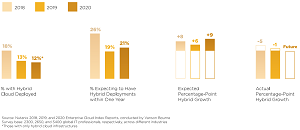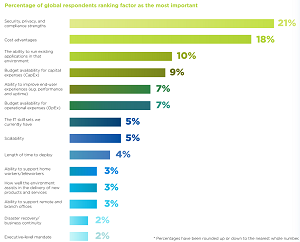News
Research Reveals What's Hindering Hybrid Cloud Adoption
For the third year in a row, research commissioned by Nutanix indicates the hybrid model is preferred by enterprises for cloud computing. However, adoption of hybrid -- a mix of both public and private cloud platforms -- remains relatively flat.
Nutanix commissioned research firm Vanson Bourne to conduct a survey of 3,400 respondents to proudce the third annual Nutanix Enterprise Cloud Index, with the sub-title, "Enterprises Embark on Hybrid IT Journey."
That journey, however, is slowed by some bumps in the road.
"Enterprise enthusiasm for the hybrid IT model has been strong for all three research years, though most businesses still struggle to fully adopt it," the report says, listing several issues that "have conspired to keep hybrid cloud deployments fairly flat to date."
 [Click on image for larger view.] Year-to-Year Hybrid Cloud Plans vs. Actual Deployments (source: Nutanix).
[Click on image for larger view.] Year-to-Year Hybrid Cloud Plans vs. Actual Deployments (source: Nutanix).
The report lists hybrid adoption impediments as:
- Tools for managing mixed cloud environments to date have been immature or scarce. However, experts say that the supply side of hybrid cloud management tools is "coming of age" in 2020, so significant improvements are likely to come.
- IT teams are short on in-house skills that bridge on-prem and public cloud tech. More than a third of respondents (37 percent) say their organizations lack the skills to manage hybrid cloud infrastructure, in part because different cloud technologies work differently.
- New cloud options complicate decision-making. From public clouds extending into a customer's IT environment to private clouds running in different locations, the widening array of offerings is causing IT pros to reevaluate their overall cloud strategies.
- Changing privacy laws. Stricter laws about where customer data can be stored have forced IT leaders to rethink where their existing workloads are allowed to run. Nearly three-quarters (73 percent) of respondents to the Second Annual ECI study in 2019, for example, brought some applications and data back from public clouds to on-prem environments as a result.
While the report discusses relatively flat adoption of the hybrid model, cloud computing in general is enjoying a boom caused by the COVID-19 pandemic, which forces many people to work from home and use cloud tech to get their jobs done while staying in touch and collaborating with co-workers. Many studies have alluded to this, including one we reported on in the article "COVID-19 Fuels Cloud Computing Spending Boom."
 [Click on image for larger view.] Top Infrastructure Decision Factors (percentage of global respondents ranking factor as the most important) (source: Nutanix).
[Click on image for larger view.] Top Infrastructure Decision Factors (percentage of global respondents ranking factor as the most important) (source: Nutanix).
In the new Nutanix report, this also holds true.
For example, one of the report's main takeways is "The global pandemic has raised IT's profile and fueled cloud adoption." Explaining further, the report says, "More than three-fourths (76 percent) of respondents said COVID-19 has caused IT to be viewed more strategically in their organizations. In addition, 46 percent of respondents said they increased their hybrid investments as a direct result of the pandemic."
Furthermore, another pandemic-related takeway is, "Respondents running hybrid clouds are planning to focus on driving positive business impact as a result of COVID-19."
Backing that claim up, the report says, "Companies running hybrid cloud environments are more likely to say that they're planning on making their organization more agile and seek out ways to become more competitive as a result of COVID-19, compared to organizations using other deployment models. Additionally, they are also more likely to offer flexible work options and strengthen their business continuity plans because of the pandemic. This finding implies that a hybrid cloud infrastructure positions them more favorably to achieve these goals than other setups might."
Other key takeaways listed by Nutanix include:
- Most enterprises have embarked on a journey to reach their IT operating model of choice: hybrid cloud infrastructure. Global respondents report taking the initial key steps to successfully run a hybrid cloud environment, which 86 percent consider their ideal operating model. These measures include adopting hyperconverged infrastructure (HCI) in their datacenters and decommissioning non-cloud-enabled datacenters in favor of private and public cloud usage. Respondents also reported running a mixed model of private cloud, public cloud, and traditional datacenter more often than any other (26 percent), likely a stepping stone toward a fully integrated hybrid cloud environment.
- Global IT teams are planning substantial infrastructure changes. They foresee hybrid cloud deployments increasing by more than 37 percentage points over the next five years and a corresponding 15-point drop in non-cloud-enabled datacenters.
- Strategic business outcomes are driving change more so than economics. Respondents said their primary motives for modifying their IT infrastructures are to get greater control of their IT resources (58 percent), gain the flexibility to meet dynamic business requirements (55 percent), and improve support for customers and remote workers (46 percent respectively). By contrast, just 27 percent mentioned cutting costs as a driver.
- Businesses increasingly rely on multiple public clouds to meet their needs. Among those who use public clouds, 63 percent of respondents use two or more public clouds, or multicloud Respondents are expecting this number to jump to 71 percent in the next 12 months. This indicates that businesses are looking for the flexibility delivered by different public cloud providers.
Nutanix is a cloud computing company that sells hyper-converged infrastructure software, cloud services and software-defined storage, according to Wikipedia.
About the Author
David Ramel is an editor and writer at Converge 360.